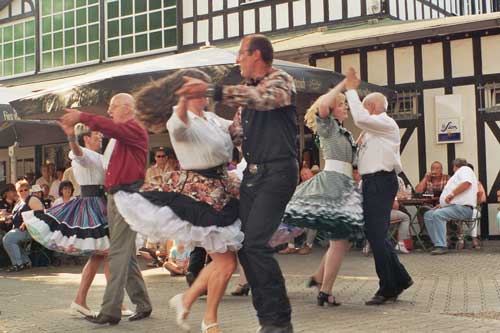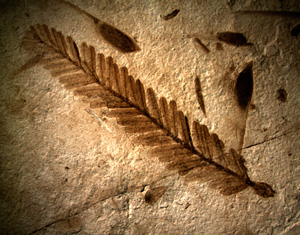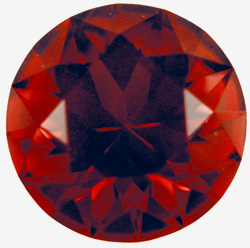Dance, State
 Square dancing, reflecting Oregon's pioneer heritage and friendly character, was declared the official state dance in 1977.
Square dancing, reflecting Oregon's pioneer heritage and friendly character, was declared the official state dance in 1977. In 1977, the Legislature declared the Square Dance to be Oregon’s state dance. The dance is a combination of various steps and figures with four couples grouped in a square. The pioneer origins of the dance and the characteristic dress are deemed to reflect Oregon’s heritage. The lively spirit of the dance exemplifies the friendly, free nature and enthusiasm that are part of the Oregon character.
Deaths
42,312 (2023 preliminary)
Divorces
11,699 (2023 preliminary)
Electoral Votes for President
8
Fair, Oregon State: Early History
1858: The State Fair was unofficially started by a group of farmers known as the Oregon Fruitgrowers Association.
1861: The first official Oregon State Fair was held along the Clackamas River in the Gladstone/Oregon City area.
1862: The second State Fair took place in Salem, at the same location where it is held today.
Fish, State
The Chinook Salmon (Oncorhynchus tshawytscha), also known as the spring, king or tyee salmon, is the largest of the Pacific salmons and the most highly prized for the fresh fish trade. Declared the Oregon state fish by the 1961 Legislature, the Chinook Salmon is found from southern California to the Canadian Arctic.
Flag, State
The state flag, adopted in 1925, is blue with gold lettering and symbols. Blue and gold are the state colors. On the flag’s face the legend "STATE OF OREGON" is written above a shield, which is surrounded by 33 stars. Below the shield, which is part of the state seal, is written “1859,” the year of Oregon’s admission to The Union as the 33rd state. The flag’s reverse side depicts a beaver. Oregon has the distinction of being the only state in The Union whose flag has different patterns on each side. The utility flag has a plain border, and the dress or parade flag has gold fringe.
Flower, State
The Legislature designated the Oregon Grape (Mahonia aquifolium) as the state flower by resolution in 1899. A low-growing plant, the Oregon Grape is native to much of the Pacific Coast and is found sparsely east of the Cascades. Its year-round foliage of pinnated, waxy green leaves resemble holly. The plant bears clusters of small yellow flowers in early summer and dark blue berries that ripen in the fall. The fruit can be used in cooking.
 Metasequoia, the state fossil. (Image courtesy John Day Fossil Beds National Monument)
Metasequoia, the state fossil. (Image courtesy John Day Fossil Beds National Monument) Fossil, State
The Legislature designated the Metasequoia, or Dawn Redwood (Metasequoia glyptostroboides), as the state fossil by resolution in 2005. The Metasequoia flourished in the Miocene Epoch of 25 to 5 million years ago and left its record embedded in rocks across Oregon’s landscape. While long extinct in Oregon, paleontologists discovered living 100-foot Metasequoia trees in a remote area of China in the 1940s and brought specimens back to the United States for propagation to ensure Metasequoia trees can be found today.
Fruit, State
The Legislature designated the pear (Pyrus communis) as the state fruit by resolution in 2005. Oregon produces a variety of pears, including Comice, Anjou, Bosc and Bartlett. The pear ranks as the top-selling tree fruit crop in the state and grows particularly well in the Rogue River Valley and in the area between the Columbia River and Mt. Hood.
Gemstone, State
The 1987 Legislature designated the Oregon
Sunstone as the state gemstone. Uncommon in its composition, clarity and colors, it is a large, brightly colored transparent gem in the feldspar family. The Oregon Sunstone attracts collectors and miners and has been identified as a boon to tourism and economic development in southeastern Oregon counties.
 Oregon Sunstone
Oregon Sunstone Geographic Center
The geographic center of Oregon lies in Crook County, 25 miles south-southeast of Prineville.
Gorge, Deepest
Hells Canyon, Wallowa County, Snake River: At up to 7,913' deep, it is the deepest gorge in North America.
Highways, Special Designation
Historic Columbia River Highway:
The 74-mile stretch of the Columbia River Highway from
Troutdale to The Dalles was built from 1913 to 1922. For many years, it was designated U.S. 30. Beginning in the 1950s, Interstate 84 replaced the historic highway as the main route through the Columbia Gorge. The historic highway became a National Scenic Byway All-American Road in 1999. In 2000, the U.S. Secretary of the Interior designated it a National Historic Landmark, which recognized the highway as a significant national heritage resource. The route became the first highway in the country to be given either of these national designations.
Oregon 99:
Originally known as the Pacific Highway, Oregon 99 runs from the Oregon/California border north to Junction City, where it splits into Oregon 99E and Oregon 99W. The Pacific Highway, once designated as U.S. 99, U.S. 99E and U.S. 99W, was the main north–south highway in Oregon from the 1920s until Interstate 5 replaced it in 1964.
US 101:
Completed in the 1930s, the Oregon Coast Highway (U.S. 101) runs the length of Oregon’s Pacific Coast from Astoria on the Columbia River to the Oregon/California border. The highway was designated an Oregon Scenic Byway in 1991 and a National Scenic Byway All-American Road in 2002.
Veterans Memorial Highways:
479,600 Oregon veterans have served our nation during five major wars—WWI, WWII, Korea, Vietnam, Persian Gulf/Afghanistan/ Iraq. Over 6,000 lost their lives and 15,000 were wounded during those wars.
The following highways have been designated by the Oregon Legislature and various governors to honor these veterans:
WWI Veterans Memorial Highway: U.S. 395
WWII Veterans Historic Highway: U.S. 97
Oregon Nisei Veterans WWII Memorial Highway, S.R. 35
Korean War Veterans Memorial Highway: Interstate 5
Vietnam Veterans Memorial Highway: Interstate 84
Persian Gulf, Afghanistan and Iraq Veterans Memorial Highway: U.S. 101
POW/MIA Memorial Highway: U.S. 26
Atomic Veterans and Atomic Cleanup Veterans Memorial Highway: Interstate 5 from Albany to Salem
Oregon Medal of Honor Highway: US 20
Purple Heart Trail: Interstate 5
Warm Springs Veterans Memorial Highway: US 26 within the Warm Springs Reservation
Gold Star Families Memorial Highway: Highway 30 from Astoria to Ontario
Hops Production (2023)
Acres harvested: 6,822
Yield per acre: 1,558 pounds
Oregon accounted for 10% of the United States’ hop crop in 2023.
Top varieties grown in Oregon: Citra, Mosaic, Strata, Cascade and Nugget, accounting for 64% of the state's hop production.